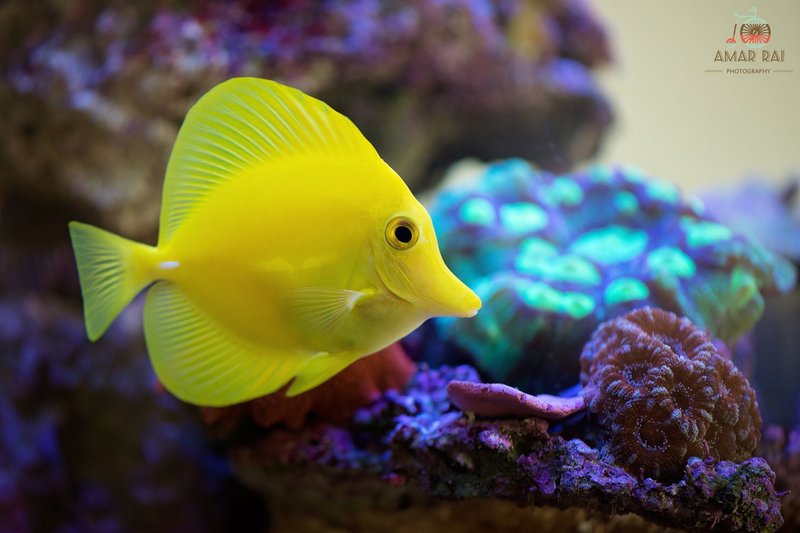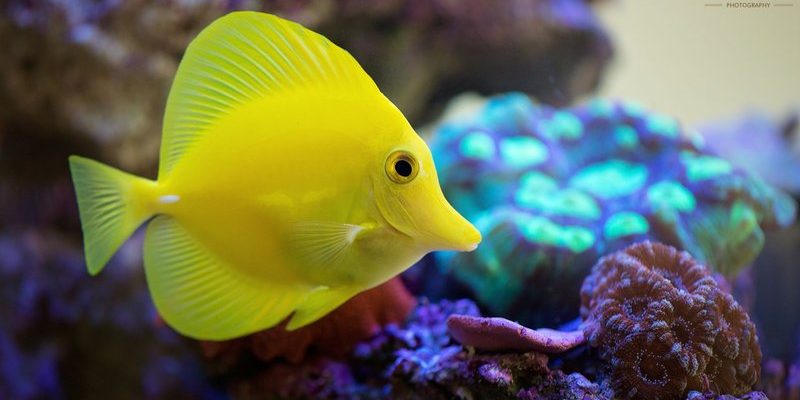
Picture a burst of sunshine gliding through the vibrant waters of a coral reef. That’s the essence of the Yellow Tang, a fish known not just for its brilliant color, but also for its lively personality and enchanting movements. Originating from the warm Pacific waters, particularly around Hawaii, this fish has captured the hearts of aquarists and nature lovers alike. Its bright yellow hue isn’t just a pretty face; it plays a crucial role in its survival, helping it blend into the shimmering underwater environment of coral reefs.
You might be wondering what makes the Yellow Tang so special beyond its stunning appearance. These fish are herbivores and have developed a unique way of maintaining the health of their habitats. They feed primarily on algae, helping to prevent overgrowth that can smother corals. This harmonious relationship between the Yellow Tang and its surroundings is a remarkable example of nature’s balance, making it a vital player in marine ecosystems.
In the following sections, we will dive deeper into the fascinating world of Yellow Tangs. From their physical characteristics to their behavior, habitat, and nutrition, this article will uncover everything you need to know about these vibrant fish. So, let’s get swimming!
Physical Characteristics of Yellow Tang
The Yellow Tang boasts a distinct appearance that makes it easily recognizable. Typically, they grow to about 7 to 8 inches long, although some individuals may reach up to 10 inches. Their bodies are oval-shaped and feature bright yellow scales that almost seem to glow under sunlight. They have a sharp spine on their tails known as a caudal spine, which they can use for self-defense against predators.
This fish also has a small mouth designed specifically for grazing on algae. You might find it amusing that their dental structure resembles a series of comb-like teeth, perfect for scraping algae off rocks and coral. This specialized mouth helps them thrive in their natural habitat where algae growth is plentiful.
Another fascinating aspect of their physical traits is their coloration. While the classic Yellow Tang is bright yellow, some variations may show orange hues or even spots. This diversity adds to their appeal, especially among aquarium enthusiasts eager to showcase the beauty of their underwater tanks.
Habitat and Distribution
Yellow Tangs are native to the warm waters of the Pacific Ocean, predominantly found in coral reefs across Hawaii and parts of the tropical Western Pacific. These reefs provide a rich habitat teeming with nutrients and shelter. The shallow waters, usually less than 100 feet deep, allow these fish to thrive.
You can frequently spot them swimming among the coral formations, where they feel safest. The open spaces in these reefs are perfect for their foraging habits. They usually stay close to structures like rocks and corals, which offer protection from predators like larger fish and sharks.
Sadly, their beautiful habitat is under threat due to pollution and climate change. Rising temperatures cause coral bleaching, severely impacting the ecosystems that Yellow Tangs rely on. Conservation efforts are crucial for ensuring that these vibrant fish can continue to thrive in their natural environment.
Diet and Feeding Habits
As herbivores, Yellow Tangs have a diet that primarily consists of algae. They play a crucial role in controlling algae growth on coral reefs by constantly grazing and preventing overgrowth that can harm corals. This natural “cleaning service” is essential for maintaining the health of their ecosystem.
In the wild, they can be seen nibbling on various types of algae, including filamentous algae and seaweed. Their unique mouths are perfectly adapted for this purpose, allowing them to scrape off the algae effortlessly. Their diet helps not only their health but also maintains the balance in their habitat by reducing competition for space and resources among many marine species.
If you’re considering keeping a Yellow Tang in an aquarium, it’s essential to replicate their natural diet. You can feed them a combination of high-quality marine flakes, algae wafers, and fresh vegetables like spinach or romaine lettuce. This diet will help them thrive and stay vibrant in the confines of an aquarium.
Behavior and Social Structure
Yellow Tangs are known for their curious and active behavior. They can often be seen swimming energetically around their environment, exploring every nook and cranny of their habitat. Their social structure varies, with some being more solitary while others prefer to school with their kind. In aquarium settings, they are typically peaceful fish but can become territorial when it comes to foraging areas.
Interestingly, they communicate with each other through body language and color changes. When excited or threatened, their colors can shift slightly, signaling their mood. This behavior helps maintain social harmony among the resident fish in their environment.
If you observe them closely, you’ll notice that they have a strong sense of curiosity. They’ll often investigate new objects or changes in their environment, which is a delightful trait for aquarists to enjoy. Just like a child discovering something new, Yellow Tangs engage with their surroundings, showcasing their lively personalities.
Reproduction and Lifespan
The reproductive habits of Yellow Tangs are fascinating. They are known to be spawning fish, meaning they release eggs and sperm into the water for fertilization. This usually occurs during specific times of the year when conditions are right—typically in warmer months when water temperatures rise. The female can lay thousands of eggs at once, which float to the surface where they are fertilized by males.
This mass spawning behavior is not only a means of reproduction but also serves to increase the chances of survival for the offspring. With so many eggs in the water, the likelihood of some surviving to adulthood is greatly enhanced. However, it’s important to note that Yellow Tangs do not provide parental care, leaving the tiny hatchlings to fend for themselves right from the start.
Keeping Yellow Tang in an Aquarium
If you’re thinking about adding a Yellow Tang to your aquarium, there are a few key factors to consider. First, they need a spacious tank—ideally at least 75 gallons—because they are active swimmers and require ample space to thrive. Overcrowding in smaller tanks can lead to stress and territorial disputes.
It’s crucial to recreate their natural environment as much as possible. This means incorporating live rock, which not only serves as a hiding place but also provides natural algae for grazing. Additionally, maintaining water quality is vital; regular water changes and proper filtration will ensure a healthy habitat.
When introducing a Yellow Tang to a community tank, be mindful of tank mates. They can sometimes be territorial, especially toward other surgeonfish or similarly shaped species. Keeping them in a peaceful environment with compatible fish will help reduce stress and aggression, allowing them to showcase their beautiful colors and behaviors.
Conservation Status
The conservation status of Yellow Tangs is of growing concern. While they are not currently classified as endangered, their habitats are threatened by overfishing, pollution, and climate change. Coral reefs, their main environment, are under significant stress from rising ocean temperatures and acidification, which can impact their populations.
Efforts to protect reef habitats are crucial for the survival of not just the Yellow Tang, but countless other marine species that share this ecosystem. Marine conservation organizations are working hard to promote sustainable fishing practices and protect coral reefs around the world.
As consumers, we can also play a role in conservation. Supporting responsible aquarists who breed fish sustainably rather than harvesting them from the wild can significantly reduce the impact on natural populations. By making informed choices, you can help ensure that future generations will also appreciate the beauty of Yellow Tangs in our oceans.
FAQ
What is the ideal tank size for a Yellow Tang?
The ideal tank size for a Yellow Tang is at least 75 gallons. These fish are active swimmers, and having a spacious environment allows them to thrive and exhibit natural behavior. Overcrowding in smaller tanks can lead to stress, which can negatively affect their health.
Can Yellow Tangs live with other fish?
Yes, Yellow Tangs can live with other fish, but caution is necessary when selecting tank mates. They can be territorial, especially towards other surgeonfish or similarly shaped species. It’s best to keep them with peaceful fish that won’t threaten their space. Gradual introductions and proper tank size can help foster a harmonious community tank.
What do Yellow Tangs eat in captivity?
In captivity, Yellow Tangs require a diet rich in algae and herbivore-friendly foods. You can provide high-quality marine flakes, algae wafers, and fresh vegetables such as spinach or romaine lettuce. This diet will help them maintain their health and vibrant coloration.
How long do Yellow Tangs live?
Yellow Tangs can live for over 20 years in captivity with proper care. In the wild, their lifespan may be shorter due to predation and environmental pressures. However, in a well-maintained aquarium setting, they can thrive for decades.
Are Yellow Tangs suitable for beginner aquarists?
While Yellow Tangs can be kept by beginner aquarists, they do require specific care and attention. Having a properly sized tank, maintaining excellent water quality, and selecting compatible tank mates are crucial for their well-being. If you’re willing to learn and put in the effort, they can be a rewarding addition to your aquarium.
What is the best way to introduce a Yellow Tang to a new tank?
Introducing a Yellow Tang to a new tank should be done gradually. Start by acclimating the fish to the new water conditions slowly, usually over a few hours, to reduce stress. Ensure that the tank is already established and has plenty of hiding spots. Keeping the tank clean and balanced will help your new fish settle in comfortably.
Do Yellow Tangs require special filtration systems?
While Yellow Tangs do not require specific filtration systems, maintaining high water quality is essential. A good-quality filtration system that can keep up with the tank’s bioload will help ensure a healthy environment. Additionally, regular water changes will further enhance the water quality, contributing to the overall health of the fish.
Can Yellow Tangs change color?
Yes, Yellow Tangs can slightly change color based on their mood and environment. When excited or threatened, their colors may appear more vibrant, while stress may cause them to dull. These color changes act as both a communication method and a response to their surroundings.
What are the signs of a healthy Yellow Tang?
Signs of a healthy Yellow Tang include vibrant coloration, active swimming, and a hearty appetite. They should be responsive and curious about their environment. Look for clear eyes and unblemished skin; signs of stress or illness may include lethargy, lack of appetite, or frayed fins.
Is it safe to keep Yellow Tangs with invertebrates?
Generally, Yellow Tangs can coexist with certain invertebrates in a home aquarium. However, caution should be taken, as they may nibble on some invertebrates, especially if they are algae eaters themselves. Researching specific tank mates and monitoring their interactions can help ensure a peaceful environment.
What role do Yellow Tangs play in their ecosystem?
Yellow Tangs play a vital role in their ecosystem by controlling algae growth on coral reefs. Their grazing habits prevent overgrowth, which can smother corals and disrupt the balance of the reef community. By keeping algae in check, they contribute significantly to the overall health and sustainability of marine ecosystems.

